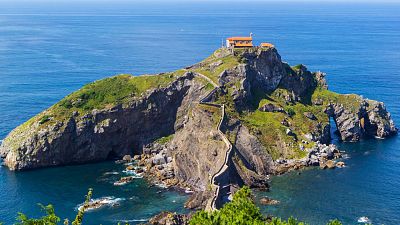Which destinations are limiting visitors in Spain?

Spain is known for its white sand beaches, rugged landscapes, and sweeping vistas. But these beautiful landscapes are under threat from the trampling and mistreatment from thousands of tourists.
According to a survey by Eco-union, an ecology NGO,16 million visitors descend upon Spain’s national parks every year – an increase of 77 per cent over the past two decades.
“They have intensified in protected areas in general in the last few years.”
To protect these natural beauty spots, many Spanish regions have imposed visitor caps and restrictions.
If you’re planning a visit to one of these stunning locations, here’s what you need to know.
Which Spanish tourism destinations are limiting visitors?
Most of Spain’s national parks impose some restrictions on incoming visitors.
Doñana National Park, Andalusia
Famed for its wetlands and ‘pink carpet’ of flamingos, this national park restricts daily visitors on several popular routes – for example, just 886 people are allowed per day on the routes from Huelva to El Acebuche and El Rocío.
To bag your spot, you can book a guided tour online through a few different websites.. If you wish to explore the park on your own, you can meander the boardwalk paths around the five visitor centres.
Martimo-Terrestre de Cabrera National Park, Balearic Islands
This sweeping marine park – the largest in Spain – covers 908 square kilometres. Mostly ocean, it also boasts the secluded Cabrera Archipelago. To prevent overtourism, visitors on boats must apply for a pass and may only anchor in two specified locations. Scuba diving is strictly limited. Passes for both activities can be booked here.
Mount Teide National Park, Tenerife
Mount Teide is the largest and oldest of the Canary Islands’ national parks. It’s also one of the most popular, with 15 million visitors a year. If you want to climb its ancient volcano, book in advance here – just 200 people per day are allowed on the last stretch of path up to Teide’s peak.
Murcia national parks
Private cars are heavily limited in the regional natural parks of Calblanque, Monte de las Cenizas, and Pea del Guila. During the pre-season, the number of cars in each park cannot exceed the number of parking bays – a rule that is enforced at manned entry barriers. Between late June and August, private vehicles are completely banned, with visitors offered buses instead.
Picos de Europa National Park, Asturias
During peak season, tourists can only reach the popular Covadonga lakes by bus or authorised taxi. The road can be closed at short notice when the parking lot fills up.
Praia das Catedrais, Galicia
The ‘cathedrals’ beach is famous for its majestic natural rock formations, sculpted by the sea over thousands of years. To visit from July-September and during Holy Week (April 2-8, 2023) you must reserve a free ticket online in advance. Visitors are capped at 5,000 per day, and you can book here.
San Juan de Gaztelugatxe, Basque country
This tiny island became world famous after it was featured in the smash-hit TV show Game of Thrones. Visiting is free, but if you want to climb its winding steps, make sure you book a ticket before your visit. Just 1,500 visitors are allowed to visit per day and you can book here.
Sierra de Guadarrama National Park, Madrid
The green pools of La Charca Verde are a popular beauty spot. Faced with soil erosion and fauna disruption, the national park authority has limited the number of daily visitors in cars to 270. Details of restrictions can be found here.
Urbasa Natural Park
The river Urederra boasts stunning turquoise water and flowing waterfalls. However, access to the source of the river is now limited to 500 vehicles per day. Further information on restrictions and bookings can be found here.
Valle de Cabriel Biosphere Reserve, Castilla–La Mancha
This famous area is known as the setting of Don Quixote of La Mancha. It is also home to the Chorreras del Cabriel waterfalls in Cuenca, but just 400 people per day are permitted to enter the surrounding reserve. You can book online here.
Other national parks with visitor caps include Serra d’Irta Natural Park in Valencia and Aragón’s Ordesa y Monte Perdido National Park.
How else is Spain limiting tourism?
National parks aren’t the only Spanish destinations imposing restrictions on tourists.
Spain is the second most visited country in the world, after France. Tourism is an important pillar of the economy – but also drives prices up for locals, making cities prohibitively expensive.
To counter the impacts of overtourism, Barcelona charges a tourist levy, visitors must cough up €3 for a stay of more than 12 hours and €1 for a stay of less than 12 hours. These costs – along with an existing €1.75 surcharge – are commonly added to the price of booking cruises or hotels.
Earlier this year, authorities announced a cruise-specific tax to help curb the pollution that these giant ships bring. They have not yet outlined how much it will set passengers back.
Elsewhere, many hotspots don’t necessarily have a problem with the number of visitors they receive – but with the way that these visitors behave.
In June, one of Majorca’s most popular party districts – Playa de Palma – banned people wearing football shirts from entering restaurants. It was part of a wider dress code designed to discourage drunken bad behaviour.
This new restriction complements existing rules that limit so-called ‘excess tourism.’ Resorts in Magaluf, Playa de Palma and aSn Antonio in Ibiza have banned all-you-can-drink deals, bar crawls and happy hours among other measures to curb excessive alcohol consumption.
